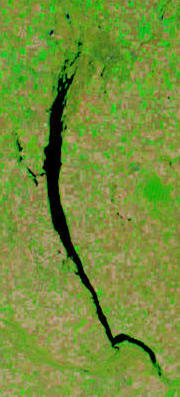Last Mountain Lake
| Last Mountain Lake | |
|---|---|
 Last Mountain Lake | |
| Location | Saskatchewan |
| Coordinates | 51°10′N 105°15′W / 51.167°N 105.250°W |
| Lake type | prairie lake[1] |
| Primary inflows | Lanigan Creek, Lewis Creek, Arm River, Saline Creek |
| Primary outflows | Last Mountain Creek |
| Basin countries | Canada |
| Max. length | 93 km (58 mi) |
| Max. width | 3 km (2 mi) |
| Surface area | 215 km2 (83 sq mi)[2] |
| Average depth | 35 m (115 ft) |
| Max. depth | 40 m (130 ft) |
| Islands | several in the north |
| Settlements | none |
| Designated | 24 May 1982 |
| Reference no. | 239[3] |
Last Mountain Lake, also known as Long Lake, is a prairie lake formed from glaciation 11,000 years ago. It is located in south central Saskatchewan, Canada, about 40 km (25 mi) northwest of the city of Regina. It flows into the Qu'Appelle River via Last Mountain Creek which flows past Craven. It is approximately 93 km long, and 3 km wide at its widest point.
It is the largest naturally occurring body of water in southern Saskatchewan, although Lake Diefenbaker (created by damming) is larger. The lake was named for a Plains Cree legend about the Great Spirit shovelling dirt from the valley the lake now occupies and forming Last Mountain Hills east of Duval. The lake is a popular resort area for residents of southeastern Saskatchewan.

History
Access to the area was opened up by the Qu'Appelle, Long Lake and Saskatchewan Railroad and Steamboat Company who also operated steamships on the lake.[4]
Last Mountain House
"Last Mountain House" was a Hudson's Bay Company trading post from 1869 to 1871. It was a branch of Fort Qu'Appelle 75 km east and was about 85 km southwest of Touchwood Hills Post. It was founded in part to compete with the increasing number of independent traders in the area and because the buffalo had moved south from Touchwood Hills. Unlike most HBC posts it had no stockade. The first season was successful, producing around 1,000 buffalo robes. In the second year of operation the buffalo had moved further south and there was a serious shortage of pemmican. Some time after the second season the post was completely destroyed by fire and was not rebuilt. It was located on the east side of Last Mountain Lake about a mile north of the lake's outlet 7 km northwest of Craven, Saskatchewan and about 40 km northwest of Regina.
Resort communities


Resort communities such as Kannata Valley, Arlington Beach, Grandview Beach, Eldora Beach, Regina Beach, Saskatchewan Beach, Buena Vista, Glen Harbour, Alice and Wee Too Beach, Colesdale Park, Spring Bay, Pelican Pointe, Sunset Cove, Island View, Etter's Beach, and Mohr's Beach are on the shores of the lake.[5]
Parks
Near the town of Strasbourg along the lake's eastern shore lies Rowan's Ravine Provincial Park. This park includes a full-service marina for boaters, a full-service campground, restaurant, mini-golf, and other facilities including a large sandy point that serves as a beach. The marina is often used by recreational boaters and sailors traveling from Regina Beach as a stop over or refueling point, and holds a large fishing tournament every September. Last Mountain House Provincial Park is located on the south-east shore and provides tours of historical Last Mountain House, which was built by the Hudson's Bay Company in 1869. The United Church of Canada's Lumsden Beach Camp is "[a] short drive from Regina, ...hugging the south shore of Last Mountain Lake."[6]
Last Mountain Lake Bird Sanctuary
The Last Mountain Lake Bird Sanctuary, the first federal bird sanctuary in North America, was established here in 1887. As the first such wildlife reserve of this kind on the continent, it was designated a National Historic Site of Canada in 1987.[7] Over 280 bird species have been recorded. The lake contains appropriate habitat for 9 of Canada's 36 species of vulnerable, threatened and endangered bird, such as the peregrine falcon, piping plover, burrowing owl and whooping crane. The northern end of the lake is very shallow and contains wetlands. Part of this area of the lake and surrounding area has been set aside as the Last Mountain Lake National Wildlife Area, which is a site of regional importance in the Western Hemisphere Shorebird Reserve Network.[8][9]
Fish species
The lake contains a host of fish species including walleye, yellow perch, northern pike, burbot, lake whitefish, cisco, bigmouth buffalo, white sucker and common carp.
References
- ^ "Natural Resources Canada-Canadian Geographical Names (Last Mountain Lake)". Retrieved 2014-08-29.
- ^ https://www.anglersatlas.com/lake/690420#map=9/-11696427.08/6632406.85
- ^ "Last Mountain Lake". Ramsar Sites Information Service. Retrieved 25 April 2018.
- ^ "A History of Regina in Photographs". Regina Public Library. Retrieved 2011-03-05.
- ^ "Atlas of Canada Toporama". Retrieved 2014-08-29.
- ^ http://www.lumsdenbeachcamp.com/ June 2, 2013.
- ^ Last Mountain Lake Bird Sanctuary. Canadian Register of Historic Places. Retrieved 18 August 2012.
- ^ "Saskatchewan's Environmental Champions (Last Mountain Lake Bird Sanctuary)". Archived from the original on 2014-01-07. Retrieved 2014-08-29.
- ^ "Last Mountain Lake National Wildlife Area: Site Description". Manomet Center For Conservation Sciences. Retrieved 2008-02-18.
- Elizabeth Browne Losey,"Let Them be Remembered:The Story of the Fur Trade Forts, 1999, pages 668-672
- Canada's Historic places
- Saskatchewan Parks

